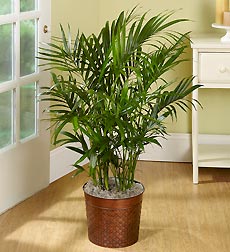





Botanical Name: Chamaedorea cataractarum
Cat palm tree makes a dramatic house plant and is easy to grow if you give it what it needs.
This lush, tropical palm will thrive in bright light. If you have a sunroom or a sunny window, keep it there.
Give your palm a quarter turn once a week so that all sides are exposed to sunlight. A large plant can be
placed on a plant caddy
to make it easy to move.
Cat palm trees grow in stemless clumps. The pinnate leaves have leaflets that will reach up to 1 ft (30 cm) long and 1 in (2.5 cm) wide. Keep palm fronds clean by gently wiping them with a damp cloth.
This palm needs more moisture than some. Water enough to keep the soil evenly moist, but never soggy. Palms are not desert plants as some people believe. Regular watering will help to prevent fronds from turning brown.
Brown leaf tips can be caused by dry soil, dry air or tap water that contains fluoride. Increase humidity around the palm, if the air is too dry. Use distilled or rain water to water your palms.
Flush Salts: Palms are sensitive to salts that accumulate in the soil. This build up of soluble salts come from the chemicals in tap water and fertilizers. They can damage foliage and roots. Fortunately, getting rid of excess salts is easy. Place your palm in a sink or take it outdoors on a warm day. Slowly pour tepid water over the potting mix. Allow water to drain out the drainage holes of the pot. Pour more water through the pot, then empty the drainage tray. Flushing salts a couple times a year will make your palm healthier and takes only minutes to do.
Repotting your palm is needed only every 3 years or so. Keeping the roots crowded helps to limit the plant's size, so use a pot that's only 1 size larger than the old pot. Don't pot the palm too deeply -- try to keep it at the same depth as it was in the old pot. Also, don't try to spread out those roots. Palm roots are brittle, so keep the root ball intact as much as possible.

Origin: Southern Mexico
Height: Up to 6 ft (1.8 m) indoors
Light: Bright light
Water: Keep soil moist all year long. Put it in a pot with drainage holes to prevent soggy soil. Palms don't like their feet wet.
Humidity: Moderate humidity. If the relative humidity drops below 50%, use a humidity tray or room humidifier. Cat palm also loves to be misted.
Temperature: Average room temperature 60-75°F/16-24°C year-round.
Soil: Use a peaty mix that drains well. Mix 1 part sand to 3 parts African violet mix.
Fertilizer: Feed once in spring and again in summer with a time-release fertilizer. I like to use
Jobe's Indoor Palm Fertilizer spikes.
It contains the micronutrients that palms need to keep them lush and green.
Propagation: Palms can be grown from seeds, but seeds are slow to germinate and seedlings so slow-growing, you'll wait several years for them to grow into trees. Although Cat palms grow in clumps, I wouldn't try to divide them. Cat palm tree roots are fragile and are easily damaged by pulling apart the root ball.
Copyright © www.100flowers.win Botanic Garden All Rights Reserved